Digital Posters
Pulse Sequence I
ISMRM & SMRT Annual Meeting • 15-20 May 2021

| Concurrent 1 | 19:00 - 20:00 |
4184.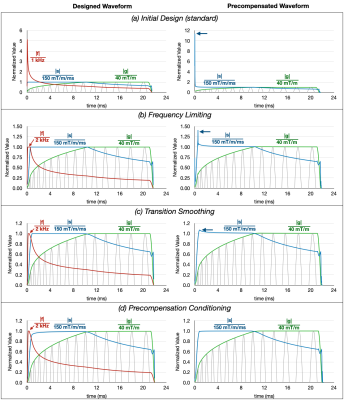 |
A Revised Algorithm for Spiral Gradient Waveforms with a Compact Frequency Spectrum
James Pipe1
1Mayo Clinic, Rochester, MN, United States
This work presents a versatile new algorithm to design better spiral trajectories, by minimizing high spatial frequencies in the gradient waveform and dynamically compensating for preconditioning by adaptively changing the maximum gradient and slew rate limits. It has been integrated into software, and example waveforms are given.
|
|||
4185.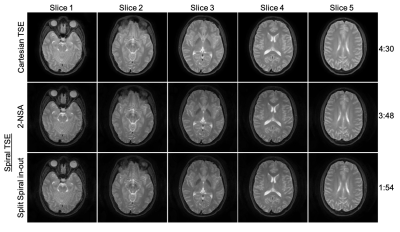 |
Accelerated Spiral Turbo-Spin-Echo Sequence with Split Spiral In-out Acquisition
Xi Peng1, Daniel Borup2, and James Pipe1
1Mayo Clinic, Rochester, MN, United States, 2Philips Healthcare, Rochester, MN, United States
Cartesian Turbo-spin-echo (TSE) has been widely used in routine clinical MRI but is subject to high specific absorption rate (SAR) and altered contrast due to long RF pulse train and reduced RF refocusing flip angles. As an alternative, spiral-TSE has been developed to produce low-SAR and improved contrast for fast T2-weighted imaging. In this work, we accelerate a previous spiral-TSE method by a factor of 2 using a split spiral-inout acquisition strategy with reversed arm orderings to intrinsically compensate for the T2-decay induced artifacts. In vivo brain experiment has been performed to demonstrate the feasibility of the proposed acquisition scheme.
|
|||
4186.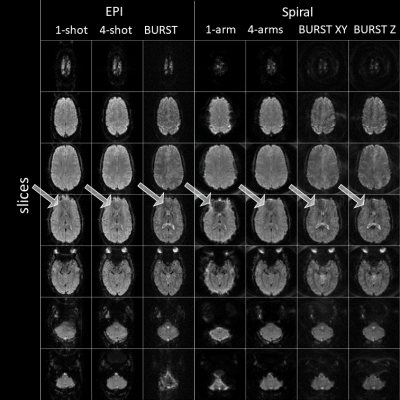 |
T2*-Weighted Imaging Using Gradient-Echo BURST Combined with EPI and Spiral Readout Trajectories
Rolf F Schulte1, Ana Beatriz Solana1, and Scott R Hinks2
1GE Healthcare, Munich, Germany, 2GE Healthcare, Waukesha, WI, United States
BURST MRI is a way of exciting magnetisation sequentially and storing it in k-space. In this work, gradient-echo BURST MRI is combined with the sampling efficient Echo-Planar Imaging (EPI) and Spiral gradient trajectories. High quality T2*-weighted images were acquired both in phantom and in vivo, demonstrating the potential of this combination for reducing B0 related artefacts.
|
|||
4187.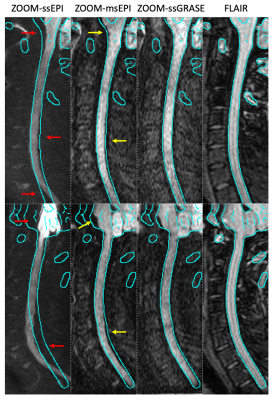 |
A single-shot GRASE technique for rapid and distortion-free diffusion-weighted spinal imaging
Zhiqiang Li1, Melvyn B Ooi2, and John P Karis1
1Neuroradiology, Barrow Neurological Institute, Phoenix, AZ, United States, 2Philips Healthcare, Gainesville, FL, United States
DWI plays a critical role in many neurological applications but its adoption in spinal imaging has been significantly hindered by geometric distortions in EPI, which is widely used in the clinic. TSE-based DWI methods, including PROPELLER and turboPROP, are free from distortion artifacts but may not be optimal for spinal imaging. In this work we present a single-shot GRASE technique with whole-mode acquisition and reduced FOV imaging to provide rapid and robust high-resolution spinal DWI. The feasibility is demonstrated and compared with ssEPI and msEPI in sagittal and axial cervical spine, and sagittal thoracic and lumbar spine.
|
|||
4188. |
Auto-calibrated simultaneous multiband cardiac GRE cine MRI at 5 Tesla
Yuan Zheng1, Lele Zhao2, Zhongqi Zhang2, Yu Ding1, and Jian Xu1
1UIH America, Inc., Houston, TX, United States, 2United Imaging Healthcare, Shanghai, China
GRE sequences benefits from increased SNR at high field and do not suffer from banding artifacts and SAR issues as bSSFP sequences, which makes it a good alternative for some applications that typically use bSSFP at 1.5 T or 3T. We have implemented the autocalibrated multiband GRE cardiac cine sequence at 5 T. The autocalibrated multiband acquisition increases the scan efficiency by reducing the scan time and simplifying the multiband imaging workflow. Iterative reconstruction with sparsity constraints was used which can also accommodate in-plane undersampling. We have evaluated this application on volunteers and achieved cardiac cine images with satisfactory quality.
|
|||
4189.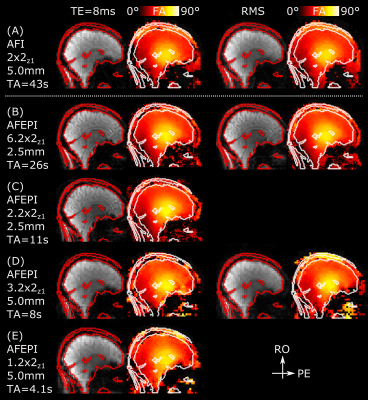 |
Rapid 3D Actual Flip Angle Echo Planar Imaging at 7 Tesla
Rüdiger Stirnberg1, Philipp Ehses1, Eberhard Daniel Pracht1, and Tony Stöcker1,2
1German Center for Neurodegenerative Diseases (DZNE), Bonn, Germany, 2Department of Physics and Astronomy, University of Bonn, Bonn, Germany
We propose a simple Actual Flip angle Imaging (AFI) modification to an existing multi-echo 3D-EPI implementation with flexible segmented CAIPIRINHA sampling. The free EPI factor choice makes more efficient use of the long optimal TRs than traditional AFI. Whole-head B1 maps at 5mm isotropic resolution can be acquired in less than 2s, however at the expense of increased signal dropouts at 7T. We explore the benefits of both reduced TEs and increased resolutions to counteract this. We find that a 2.5mm isotropic resolution single-echo protocol acquired in about 10s results in robust whole-head B1 maps with negligible dropouts and distortions.
|
|||
4190.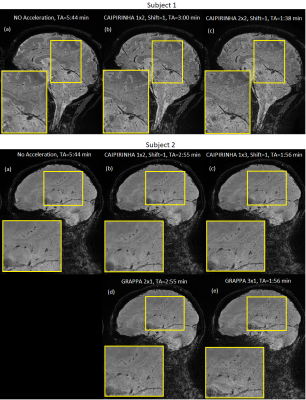 |
Segmented 3D EPI with CAIPIRINHA for Fast, High-Resolution T2*-weighted Imaging
Jin Jin1,2, Monique Tourell2, Pascal Sati3, Sunil Patil4, Kecheng Liu5, John Derbyshire6, Fei Han7, Saskia Bollmann2, Simon Robinson2, Josef Pfeuffer8, Steffen Bollmann2, Markus Barth2, and Kieran O'Brien1
1Siemens Healthcare, Brisbane, Australia, 2The University of Queensland, Brisbane, Australia, 3Cedars-Sinai Medical Center, Los Angeles, CA, United States, 4Siemens Medical Solutions USA, Baltimore, MD, United States, 5Siemens Medical Solutions USA, Baltimore, OH, United States, 6National Institute of Mental Health, Bethesda, MD, United States, 7Siemens Medical Solutions USA, Los Angeles, CA, United States, 8Siemens Healthcare, Sydney, Australia
In this work, a highly accelerated 3D EPI prototype sequence implementation and scanner in-line reconstruction are introduced. The proposed sequence provides a flexible combination of single-/multi-shot schemes, in-plane segmentation, image resolution, echo-train length, partial Fourier factors, 2D-CAIPIRINHA/2D-GRAPPA-based acceleration, and CAIPIRINHA shift. Initial tests presented herein indicate suitability for highly accelerated high-resolution susceptibility-based imaging with significantly reduced scan time, such as whole-head coverage at 0.65 mm isotropic resolution within 2 minutes.
|
|||
4191.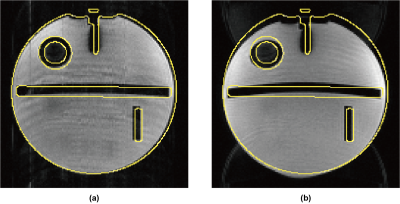 |
Interleaved single-shot EPI for geometric distortion improvement
Hao Chen1, Shiwei Yang1, Sijie Zhong1, and Zhiyong Zhang1
1School of Biomedical Engineering, Shanghai Jiao Tong University, Shanghai, China
EPI is a versatile MRI acquisition method, which can ultrafast yield an image and has been widely applied. However, EPI is well-known sensitive to B0 inhomogeneities and susceptibility effects, which leading to geometrical image distortions. In order to reduce the geometric distortion on EPI images, this work presents a new interleaved single-shot EPI method, in which ky-t line can be sampled with higher slope rate such that the geometric distortion can be alleviated. The experimental results of phantom and human brain at 3T demonstrate the capability of the new method.
|
|||
4192.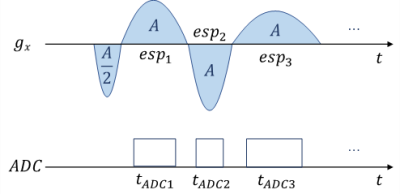 |
Varying Echo Spacing for Acoustic Noise Optimization in Single-Shot Echo-Planar Imaging
Zhenliang Lin1, Qikang Li1, Huanhuan Liu2, Ming Liu2, Qiufeng Yin2, Rui Wang3, Guobin Li3, Dengbin Wang2, and Jie Luo1
1Shanghai Jiao Tong University, Shanghai, China, 2Xinhua Hospital Affiliated to Shanghai Jiao Tong University School of Medicine, Shanghai, China, 3Shanghai United Imaging Healthcare Co., Ltd, Shanghai, China
Single-shot echoplanar imaging (EPI) sequence is a commonly used readout scheme for functional and diffusion magnetic resonance imaging (fMRI and dMRI). It features fast alternating gradient that generate loud acoustic noise, often causing discomfort for patients and even pose risk for sensitive populations. In this study, we used genetic algorithm to optimize both sound pressure level and spectral entropy for single-shot EPI sequence by varying the duration of each readout unit with a sinusoidal waveform, changing the timbre significantly with increased entropy and reduced loudness. The sequence was implemented on a 3.0T pediatric uMR Alpha system.
|
|||
4193.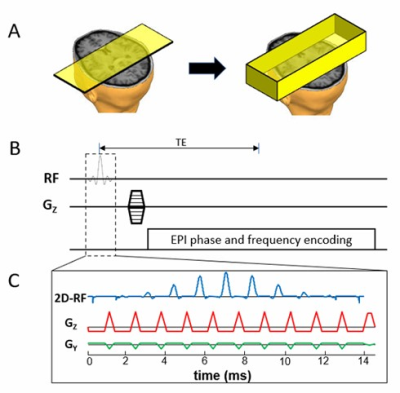 |
Three-dimensional reduced field-of-view imaging (3D-rFOVI)
Kaibao Sun1, Zheng Zhong1,2, Guangyu Dan1,2, Muge Karaman1,2, Qingfei Luo1, and Xiaohong Joe Zhou1,2,3
1Center for MR Research, University of Illinois at Chicago, Chicago, IL, United States, 2Department of Bioengineering, University of Illinois at Chicago, Chicago, IL, United States, 3Departments of Radiology and Neurosurgery, University of Illinois at Chicago, Chicago, IL, United States
Reduced field-of-view (rFOV) imaging has been achieved in 2D imaging. Although 2D rFOV can reduce image distortion and produce high in-plane resolution in EPI, the through-plane resolution remains poor and signal voids persist. We report a 3D reduced field-of-view imaging (3D-rFOVI) sequence to extend the conventional 2D rFOV imaging to 3D by using a slab-selection 2D RF pulse in conjunction with through-slab phase-encoding. This sequence features high isotropic spatial resolution in EPI images while reducing off-resonance effects that cause image distortion and signal voids. We have successfully applied the 3D-rFOVI technique to fMRI and DWI.
|
|||
4194.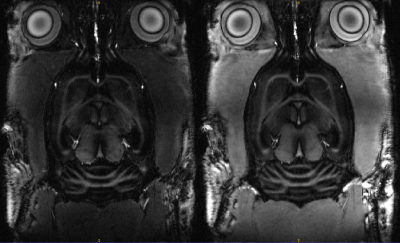 |
Contrast enhancement of a magnetization prepared steady state sequence: an optimal control framework
Benoît Vernier1,2, Eric Van Reeth1,3, Frank Pilleul1,4, Olivier Beuf1, and Hélène Ratiney1
1CREATIS, Université de Lyon, INSA Lyon, UCBL Lyon 1, UJM Saint Etienne, Unité CNRS UMR 5220, INSERM U1206, F69621, Lyon, France, 2Siemens Healthineers, Saint-Denis, France, 3CPE, Lyon, France, 4Centre Léon Bérard, Lyon, France
Optimal control in MRI has demonstrated its potential in the design of magnetization preparation in order to enhance relaxation based contrast. However, previous studies require full magnetization recovery between each TR, which induces long acquisition times and restricts its use to specific sequences. Here, a generic optimal control framework that considers a longitudinal steady state is introduced, and applied to a MP-RAGE sequence. In vitro and in vivo (rat brain) experiments validate the improvement of the contrast-to-noise ratio per unit of time when compared with an inversion-recovery preparation.
|
|||
4195.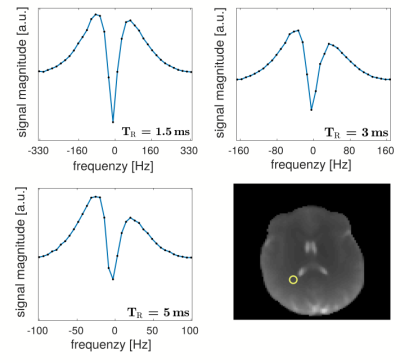 |
Pure balanced steady-state free precession (bSSFP) imaging
Jessica Schäper1,2, Grzegorz Bauman1,2, Carl Ganter3, and Oliver Bieri1,2
1Department of Biomedical Engineering, University of Basel, Basel, Switzerland, 2Department of Radiology, Division of Radiological Physics, University Hospital Basel, Basel, Switzerland, 3Department of Diagnostic and Interventional Radiology, Klinikum rechts der Isar, Technical University of Munich, Munich, Germany
For some tissues bSSFP shows a distinct asymmetry in its frequency response function. Theoretical considerations indicate that this asymmetry disappears in the limit of $$$\mathit{TR} \rightarrow 0$$$. This was studied experimentally at $$$3\,\mathrm{T}$$$ in the present work. The frequency response of bSSFP was investigated for in vivo brain for varying repetition time $$$\mathit{TR} = \{1.5,3,5\}\,\mathrm{ms}$$$. Our results give strong evidence that the asymmetry vanishes in the limit of $$$\mathit{TR} \sim 1\,\mathrm{ms}$$$ and therefore indicate that bSSFP forgets about the spectral composition and thus becomes ''pure''.
|
|||
4196.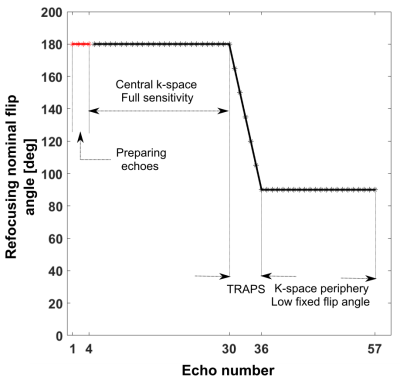 |
Half Fourier Acquisition Single Shot Turbo Spin Echo Diffusion Encoding with Transition between Pseudo-Steady States for 3T
Aidin Arbabi1 and David G Norris1
1Donders Institute, Radboud University, Nijmegen, Netherlands
Half-Fourier acquisition single-shot turbo spin-echo diffusion-weighted (HASTE DW) is a clinically established magnetic resonance imaging tool for the detection of small lesions, especially, primary and relapsing cholesteatoma at 1.5T field. HASTE DW imaging at high field strengths (3T and above) is challenging due to the intrinsic high radio frequency power deposition of the method, resulting from the extended echo train. We present a HASTE DW with smooth transition between pseudo-steady states, especially developed for 3T imaging, which features a low specific absorption rate and high quality images, without any loss of sensitivity.
|
|||
4197.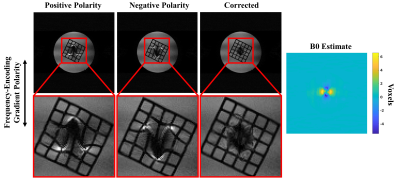 |
Achieving High Spatial Resolution with Dual Polarity Missing Pulse Steady-State Free Precession in a Clinically Relevant Scan Time
Michael Mullen1 and Michael Garwood1
1Center for Magnetic Resonance Research and Department of Radiology, University of Minnesota, Minneapolis, MN, United States
Clinical MRI sequences for imaging near metallic implants are mainly multi-spectral approaches, with fast spin-echo acquisitions and large acceleration factors to achieve clinically relevant scan times. The authors previously reported a broadband, low flip angle method at 1.5T to image with large field inhomogeneity, such as near metallic implants, quickly relative to non-spatially selective multispectral approaches. Herein it is demonstrated that this approach, dual polarity missing pulse steady-state free precession, can achieve high spatial resolutions at 3T with a large 3D FOV in a clinically relevant scan time, ~8.74 minutes.
|
|||
4198.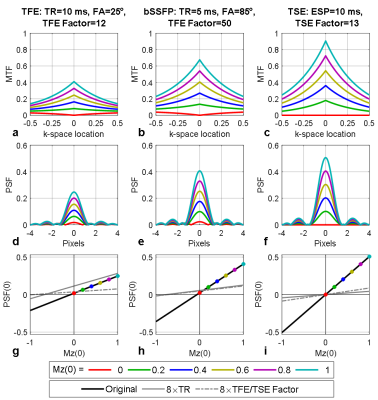 |
Analytical Characterization and Comparison of Magnetization-Relaxation-Induced Point Spread Functions of TFE, bSSFP and TSE Acquisitions
Dan Zhu1 and Qin Qin2,3
1Department of Biomedical Engineering, Johns Hopkins University, Baltimore, MD, United States, 2The Division of MR Research, Department of Radiology, Johns Hopkins University, Baltimore, MD, United States, 3F.M. Kirby Research Center for Functional Brain Imaging, Kennedy Krieger Institute, Baltimore, MD, United States
Fast image acquisition is commonly used in quantitative MRI after contrast preparation, such as turbo-filed-echo (TFE), balance steady-state-free-precession (bSSFP), and turbo-spin-echo (TSE). k-Space data acquired are filtered by a modulation transfer function (MTF), causing contrast loss and blurring. Here, we derived the analytical formulation of the corresponding point spread function (PSF) of Cartesian TFE, bSSFP and TSE with 180° refocusing. The contrast-to-noise ratio (CNR) is defined and maximized, providing an analytically optimized selection of TFE/TSE factors and flip angles. bSSFP serves high CNR, small FWHM and large TFE factors. Long TR and short TE are suggested for TFE studies.
|
|||
4199.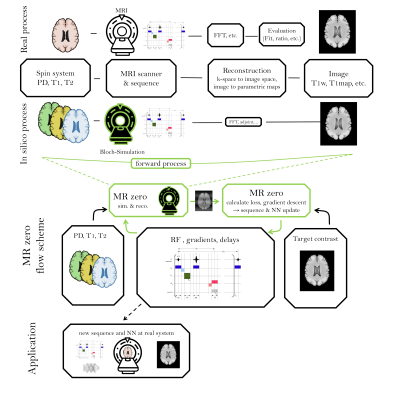 |
MRzero –- Automated invention of MRI sequences using supervised learning
Alexander Loktyushin1,2, Kai Herz1,3, Nam Dang4, Felix Glang1, Anagha Deshmane1, Simon Weinmüller4, Arnd Doerfler4, Bernhard Schölkopf2, Klaus Scheffler1,3, and Moritz Zaiss1,3
1Max Planck Institute for Biological Cybernetics, Tübingen, Germany, 2Max Planck Institute for Intelligent Systems, Tübingen, Germany, 3Eberhard Karls University Tübingen, Tübingen, Germany, 4University Clinic Erlangen, Erlangen, Germany
We propose a framework — MRzero — that allows automatic invention of MR sequences. At the core of the framework is a differentiable forward process allowing to simulate image measurement and reconstruction. The sequence parameters are variables of optimization. As a cost function we use mean squared error distance to a certain given target contrast of interest. To avoid overfitting we propose a method that generates synthetic data that is used for training. In the experiments, we demonstrate the ability of the method to learn RF flip angles and spatial encoding from scratch given a target obtained with GRE sequence.
|
|||
4200.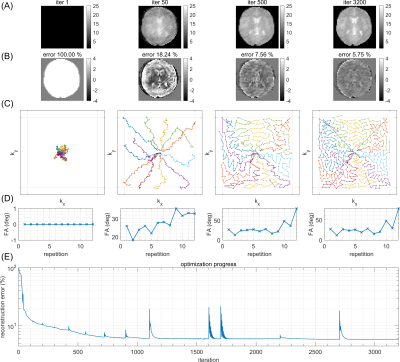 |
Advances in MRzero – supervised learning of parallel imaging sequences including joint non-Cartesian trajectory and flip angle optimization
Felix Glang1, Alexander Loktyushin1, Kai Herz1,2, Hoai Nam Dang3, Anagha Deshmane1, Simon Weinmüller3, Arnd Doerfler3, Andreas Maier4, Bernhard Schölkopf5, Klaus Scheffler1,2, and Moritz Zaiss1,3
1High-field Magnetic Resonance Center, Max-Planck Institute for Biological Cybernetics, Tübingen, Germany, 2Department of Biomedical Magnetic Resonance, Eberhard Karls University Tübingen, Tübingen, Germany, 3Friedrich-Alexander Universität Erlangen-Nürnberg (FAU), Neuroradiology, University Clinic Erlangen, Erlangen, Germany, 4Pattern Recognition Lab, Friedrich-Alexander-University Erlangen-Nürnberg, Erlangen, Germany, 5Empirical Inference, Max-Planck Institute for Intelligent Systems, Tübingen, Germany
Recently, MRzero has been proposed as a fully differentiable Bloch-equation-based MRI sequence invention framework. In this work, the approach is extended by parallel imaging capability, employing a CG SENSE reconstruction that allows optimizing for non-Cartesian sampling trajectories simultaneously with other sequence parameters like RF pulses and timings. The approach is tested herein by simulations on an in silico brain phantom and is found to yield improved reconstructions compared to regular Cartesian undersampling, and to simultaneously find variable flip angle patterns that compensate for transient signal induced blurring.
|
|||
4201.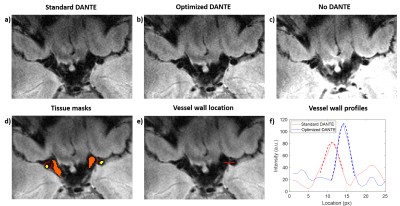 |
Optimized DANTE preparation for intracranial DANTE-SPACE vessel wall imaging at 7T
Matthijs de Buck 1, Aaron Hess2, and Peter Jezzard1
1Wellcome Centre for Integrative Neuroimaging, FMRIB Division, Nuffield Department of Clinical Neurosciences, University of Oxford, Oxford, United Kingdom, 2Oxford Centre for Clinical Magnetic Resonance Research, Department of Cardiovascular Medicine, University of Oxford, Oxford, United Kingdom
DANTE-SPACE can be used for visualizing intracranial vessel walls at 7T by simultaneously suppressing signal from the luminal blood and external CSF. However, vessel wall delineation is limited by the achieved contrast and resolution, and further improvement of the sequence is constrained by SAR. Here, an optimized protocol for the number of DANTE-pulses and the flip angle of each DANTE-pulse is proposed based on an EPG-based simulation framework. In-vivo data acquired using this DANTE preparation show an improved CNR and signal ratio between the vessel wall and both blood and CSF, while reducing the SAR compared to previous DANTE preparations.
|
|||
4202.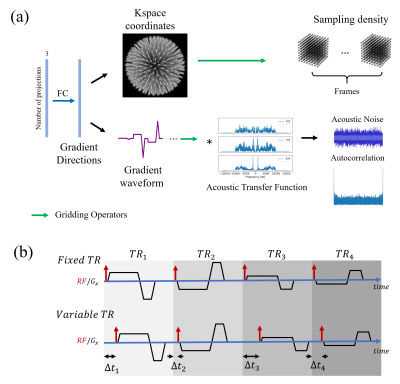 |
Acoustic and sampling optimization of 3D Radial MRI using neural network optimization
Chenwei Tang1, Laura B Eisenmenger2, Steven Kecskemeti3, and Kevin M Johnson1,2
1Department of Medical Physics, University of Wisconsin-Madison, Madison, WI, United States, 2Department of Radiology, University of Wisconsin-Madison, Madison, WI, United States, 3University of Wisconsin-Madison, Madison, WI, United States
3D radial sampling can enable ultrashort echo times, reduce sensitivity to motion, and provide high levels of acceleration. These methods have recently been used to perform free-running pediatric body imaging. However, the optimization of projection sampling remains an open problem and current schemes often produce high acoustic noise with an unfavorable noise texture. In this work, we demonstrate the optimization of trajectories using a joint consideration of sampling and acoustic performance. To perform this we introduce a neural network framework and investigate variable TR optimization as means to simultaneously distribute projections optimally and minimize acoustic noise autocorrelation.
|
The International Society for Magnetic Resonance in Medicine is accredited by the Accreditation Council for Continuing Medical Education to provide continuing medical education for physicians.